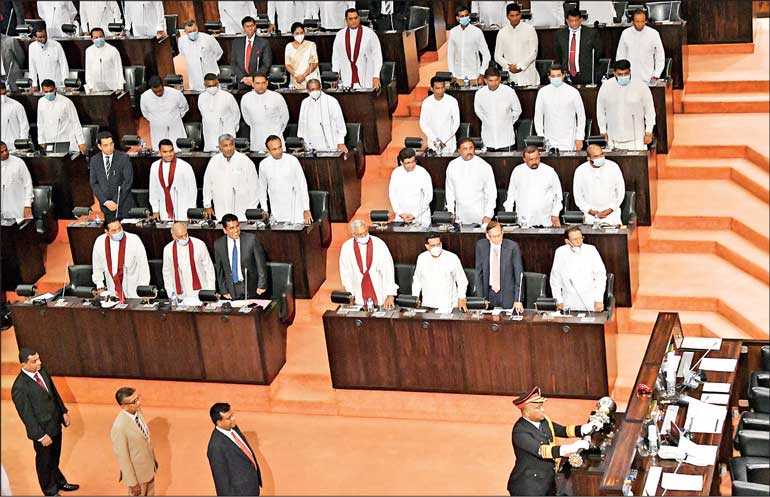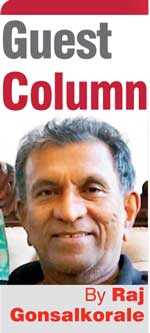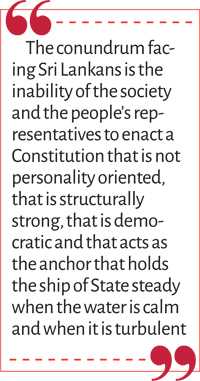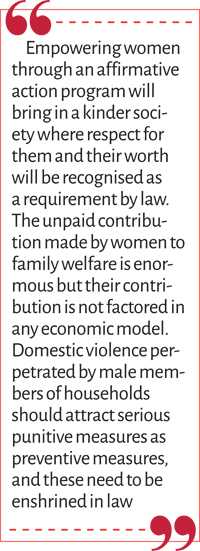Thursday Nov 21, 2024
Thursday Nov 21, 2024
Saturday, 3 October 2020 00:06 - - {{hitsCtrl.values.hits}}

The current proportional representation system, while it has its own merits, does not produce Parliamentarians who effectively and for all intents and purposes, represent the people who elect them to Parliament. It is a political party or an independent group that is voted in, and people neither have any say in any party’s promises to the people, and programs nor how candidates are picked by the parties to contest within a district. The specific parliamentarians cannot be held accountable to the promises they made, by the people who elected them – Pic by Shehan Gunasekara
 Sri Lanka’s debt to GDP ratio is expected to be more than 90% this year, and Moody’s have downgraded Sri Lanka’s sovereign credit rating by two notches, saying the South Asian nation would be hard-pressed to secure funding to service its huge foreign debt. Sri Lanka was pushed down from ‘B2’ (high credit risk) to ‘Caa1’ (very high credit risk), as the coronavirus pandemic compounded its economic woes, Moody’s said in a statement.
Sri Lanka’s debt to GDP ratio is expected to be more than 90% this year, and Moody’s have downgraded Sri Lanka’s sovereign credit rating by two notches, saying the South Asian nation would be hard-pressed to secure funding to service its huge foreign debt. Sri Lanka was pushed down from ‘B2’ (high credit risk) to ‘Caa1’ (very high credit risk), as the coronavirus pandemic compounded its economic woes, Moody’s said in a statement.
Brief pre Republic Constitutional history
Sri Lankans should be asking themselves whether the country’s Constitutions have served them and whether they have provided the structural foundation for its democratic, economic and social upliftment after 72 years of independence. Leaving aside COVID and its impact, which is severe and worldwide, it does not appear that Constitutions have provided this anchor of stability. Obviously, the fault lies not with a piece of paper but those who drafted that piece of paper.
Sri Lanka has had some form of constitutional governance for thousands of years. True, there was no written constitution, but the numerous Kings and Queens of Sri Lanka, although they had absolute power, had varying forms of governance. He or she was head of state but would be aided with high level officials and a board of ministers. The monarch was seen as the supreme ruler of the areas they ruled. The monarch also held judicial power and influence. Judicial customs, traditions and moral principles, in the main, based on Buddhism were used as the basis for the laws promulgated by the Monarchs. The laws and legal measures were proclaimed by the king, and were to be followed by the justice administration. However, the king was the final judge in legal disputes, and all cases against members of the royal family and high dignitaries of the state were judged by him. Though, the king did have to exercise this power with care and after consulting with his advisers (Wikipedia).
One definition of a constitution is that it is a body of fundamental principles or established precedents according to which a state or other organisation is acknowledged to be governed. The Merriam Webster Dictionary defines it as the basic principles and laws of a nation, state, or social group that determine the powers and duties of the government and guarantee certain rights to the people in it. Whilst not conforming strictly with these definitions, historically, Sri Lanka cannot say it functioned without Constitutions of some description.
To the best of the writer’s knowledge there was no written constitution in Sri Lanka until the British attempted to develop a representative government on the island in 1833 through a constitution that created a legislative council. This council was largely powerless, and it resigned in 1864 when their censure of the British government was ignored. The British attempted several other Constitutions to appease the populace in 1910, 1920, and 1924, but these constitutions did not provide for local governance by the native population.
The Donoughmore Constitution of 1931 finally gave some degree of authority to the elected representatives. The Soulbury Constitution was introduced in 1945 and Sri Lanka, then Ceylon, was granted independence under that Constitution in 1948. However, the country retained the Monarch of the United Kingdom as its own Monarch, and exercised that link through a Governor General as a Dominion. It took the country another 24 years, till 1972, to come to its own as a Republic.
The Republic of Sri Lanka and thereafter
The Government of Sirimavo Bandaranaike elected in 1970 with a two thirds majority established a Constitutional Assembly comprising of all elected members of Parliament. After much discussion within and with the civil society, and amidst some opposition from different quarters, promulgated the new Constitution on 22 May 1972. A ceremonial Presidency replaced the Governor General and legislative and executive power was transferred to the Parliament and the Prime Minister. The Government of J.R. Jayewardene elected in 1977 with a 5/6 majority introduced a new Constitution in 1978 which instituted a Presidential system of government with an all-powerful Executive President as the Head of State, Head of the Cabinet and the Head of the Armed Forces. The role of the Prime Minister was reduced to almost nothing and as the Prime Minister who was appointed by President Jayawardena had reportedly commented, “An Office Assistant (called a Peon), had more power than the Prime Minister”.
Since the enactment of the 1978 Constitution there have been 19 Amendments to it, with the 20th now tabled in Parliament. The current Government has also appointed a Committee to draft a new Constitution to replace the 1978 Constitution.
While Sri Lanka struggles with Constitutions and amendments, it is noteworthy that the Colonial power that introduced formal Constitutions to Sri Lanka, Britain, operates without a written Constitution, but by an unwritten one formed of Acts of Parliament, court judgments and conventions.
Professor Robert Blackburn explains this system, including Magna Carta’s place within it stating, “We certainly say that we have a constitution, but it is one that exists in an abstract sense, comprising a host of diverse laws, practices and conventions that have evolved over a long period of time. The key landmark is the Bill of Rights (1689), which established the supremacy of Parliament over the Crown following the forcible replacement of King James II (r. 1685-88) by William III (r. 1689-1702) and Mary (r. 1689-94) in the Glorious Revolution (1688).”
Post independent Constitution making in Sri Lanka
Perhaps with the exception of the 1972 Republican Constitution, it could be argued that Constitution and amendment making have been significantly influenced by personalities, and quests to perpetuate their powers. The 1972 Constitution could be described as an ideology driven exercise that freed Ceylon from the remaining links to its Colonial master Britain, and established the new Sri Lanka as its own master of destiny. While some may argue otherwise, it is difficult to see how it enhanced and perpetuated the power of the Prime Minister who already enjoyed executive power, although answerable to the Parliament.
The 1978 Constitution on the other hand was a major shift where power was transferred to a single individual, a President, invested with broad executive powers and who was not responsible to the Parliament. Legislative power remained with the Parliament but the 5/6th majority that the President’s political party enjoyed ensured that the legislative agenda was in fact his agenda. In this context, it is difficult to argue against the fact that the 1978 Constitution was personality driven and was a move to enhance an individual’s power.
There have been subsequent attempts to draft new Constitutions and perhaps the most controversial one being the one authored by late Dr. Neelan Tiruchelvam and Professor G.L. Peiris during the Chandrika Kumaratunga Presidency. Dr. Tiruchelvam paid with his life for doing this as the LTTE murdered him as its leader Prabakaran regarded Dr. Tiruchelvam as a traitor for doing this.
The 18th and 19th Amendments to the 1978 Constitution show a significant degree of personality politics. The 18th Amendment did away with the term limits specified earlier (maximum of two terms to any individual), and some of its other provisions reverted considerable powers that were modified in the 17th Amendment. The 19th Amendment sought to limit the powers of an individual bestowed with such powers in the 18th Amendment and transferred most executive powers to the Parliament and the Prime Minister.
Even the drafters of the 19th Amendment concede that it had shortcomings and they attribute this to the power rivalry between the President elected in 2015 under the 18th Amendment, and the Prime Minister who wanted executive power shifted to the Office of the Prime Minister. They were from two different major political parties in the country, and naturally, neither could agree on a workable, sustainable solution. Their power rivalry retarded the economic development of the country that had been gathering pace after the war against the LTTE, and also resulted in the return of an Islamic terrorist attack on innocent civilians praying in a Catholic Church killing more than 300 people.
Now, the country has been presented with a draft of the 20th Amendment which intends to return executive power back to the President and limiting the role of the Prime Minister. Besides this, the amendment also changes some other clauses in the 19th Amendment and reverts to what was in the 18th Amendment in some instances. Here again, it is difficult to argue against the contention presented by some that certain clauses in the 20th Amendment have been introduced in order to strengthen the hand of an individual rather than as measures to address anomalies in the 19th Amendment. These contentions also extend to the belief that such clauses erode the independence of the Independent Commissions.
The conundrum facing Sri Lankans is the inability of the society and the people’s representatives to enact a Constitution that is not personality oriented, that is structurally strong, that is democratic and that acts as the anchor that holds the ship of State steady when the water is calm and when it is turbulent.
There are a few fundamental issues that have been pointed out by legal personalities. Firstly, the question of exercise of people’s sovereignty. They contend that there is confusion when two seats of power, the President, and the Parliament and the Prime Minister, claim they represent that sovereignty. While the exercise of that sovereignty can be more clearly defined, and powers assigned, in practice it has proven to be a very difficult and challenging task.
The country witnessed this confusion when Chandrika Kumaratunga was the President and Ranil Wickremesinghe was the Prime Minister in 2002. Unknown to and without any approval from the President, the Prime Minister entered into a peace accord with the LTTE leader Prabakaran. The Parliament too was not consulted and approval obtained for this.
The issues between President Sirisena and Prime Minister Wickremesinghe between 2015 and 2019 are too numerous to mention, and they demonstrated the unworkability of a divided exercise of people’s sovereignty beyond any doubt.
People’s sovereignty
In addition to this major issue, there is also a question mark as to whether Parliament actually exercises people’s sovereignty. The current proportional representation system, while it has its own merits, does not produce Parliamentarians who effectively and for all intents and purposes, represent the people who elect them to Parliament. It is a political party or an independent group that is voted in, and people neither have any say in any party’s promises to the people, and programs nor how candidates are picked by the parties to contest within a district. The specific parliamentarians cannot be held accountable to the promises they made, by the people who elected them.
People only have the ability to pick amongst the list of such candidates with their preference votes. Whatever the legal position on this and the view of Constitutional Pundits, the end result for a voter is that no one directly represents them in Parliament and people have no avenue to express their sovereign rights. This major anomaly needs to be addressed.
The other major issue is about how the rights and interests of minorities and women find expression in the Constitution. The notion that all are equal in the eyes of the law and the Constitution is a noble motherhood statement, but in practice and in reality, this is not so. Both sections of society need affirmative action to make sure the majority view does not trample on the rights of these two major groups. Ironically, the female population in Sri Lanka in fact is the majority population (almost 52%), yet, the country is dominated by the male population as seen by the fact that there are only 12 female parliamentarians out of the total 225 in the newly elected Parliament.
While there is no doubt there are many other challenges, the above mentioned fundamental ones need to be addressed in a future Constitution. As opined by some, the Constitution should have some key areas protected by law. Firstly, how people’s sovereignty is to be exercised. Secondly, how the powers of the President, the Parliament and the Prime Minister are to be assigned. Third, how affirmative action is to be assured for minorities and women. The Sri Lankan society will not be a just society unless and until these key policy areas are addressed.
The areas more in the limelight are issues like political devolution, and self-determination for sections of the society. These issues arise due to the weaknesses and/or lack of a coherent policy on the above mentioned three areas. Political devolution to the provinces could become superfluous if a policy on affirmative action for minorities and other disadvantaged groups is enshrined in the Constitution. In its place, one could have more and more administrative devolution as that will matter more for people when it comes to their day to day lives. Something is not right if the President of the country has to intervene to get a culvert done in a village or to get a leaking water pipe fixed. These minor administrative matters, no doubt major ones for the communities involved, has to be attended at grass root level. Administrative devolution, rather than political devolution, and with the minimum of political interference will serve the grass roots far more effectively than now.
Empowering women through an affirmative action program will bring in a kinder society where respect for them and their worth will be recognised as a requirement by law. The unpaid contribution made by women to family welfare is enormous but their contribution is not factored in any economic model. Domestic violence perpetrated by male members of households should attract serious punitive measures as preventive measures, and these need to be enshrined in law.
Affirmative action need not be a permanent feature once its objectives have been achieved, and there is genuine equality. But without it, there is much less chances of achieving equality for minorities, disadvantaged groups and women.
The fundamental test that should be applied to a new Constitution is whether it has the ability to provide the structural stability to free Sri Lanka from its debt trap, its perilous economic situation, its social inequities, and to move forward as a Nation that is proud of its people, its cultures and its languages.